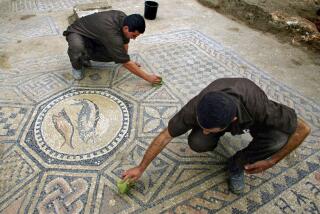Exhibit Is a Reminder of Salad Days
- Share via
Reverence for history and culture is commendable. But tossing together a strange salad of ancient artifacts and art objects that clearly constitutes three separate, small and mediocre exhibits--pretending they form a cohesive exhibition and promoting the whole as if it were a cohesive exhibition--is not sound museum practice.
Such is the case with the tenuously related array of objects called “The Holy Land: David Roberts, Dead Sea Scrolls, House of David Inscription,” at the Bowers Museum of Cultural Art in Santa Ana through Jan. 9.
The show does contain two gems: the House of David Inscription, found in Israel in 1993 and on loan for the first time outside that country, and two fragments of the Dead Sea Scrolls.
Important as these objects are, they are small in number and not worthy of an entire exhibition.
The rest of the objects on display seem added on to pad the show. The padding includes 15 or so artifacts of various types and from various time periods on loan from the Israel Antiquities Authority, including a replica of crucified heel bone, a Canaanite amulet, plates, jugs and scepters. Also on view are 50-odd 19th century lithographs, melodramatic views of the Middle East by Scottish artist David Roberts, made in 1838-39 before Europe colonized the region. They are on loan from the Duke University Museum of Art, organized as part of the Israel/North Carolina Cultural Exchange.
You can also see a small group of undistinguished early 20th century photographs of the Holy Land, borrowed from the Ecole Biblique et Archeologique Francaise de Jerusalem.
Oddly, the Bowers has given Roberts top billing in the show’s title, couching the antiquities as ancillary or complementary objects in a museum brochure--though the reverse seems obvious.
The museum also takes credit for organizing this exhibition as a whole. But given the disparate parts and players involved, this claim seems dubious.
Granted, two local curators were involved. Ran Boytner is a research associate at UCLA’s Cotsen Institute of Archaeology and a research fellow with Getty Conservation Institute. Lynn Schwartz Dodd is lecturer and curator at the Archaeological Research Collection of USC’s School of Religion.
Their curatorial duties seem limited, however, given the lack of a larger informed context for the whole pastiche and the lack of a catalogue. Still, the scroll fragments and House of David Inscription are notable. Written in Aramaic on pieces of a stone stele, the House of David Inscription contains the first and only known reference to King David’s dynasty, and possibly King David himself, outside the Bible. It may establish the historical authenticity of the legendary Israelite king.
The Dead Sea Scroll parchments date from the 3rd century BC to the 1st century. Some are believed to be the oldest existing copies of the books of the Old Testament. On view at the Bowers are parts of “The Psalms Scroll From Qumran” and “War of the Sons of Light and the Sons of Darkness,” which describes an apocalyptic war at the End of Days.
These antiquities are not without their scholarly controversies, though you wouldn’t know it from the Bowers exhibit.
Scattered text panels offer only fleeting mention of scholarly questions and scant insight into the purported relationships between the photographs, lithographs and artifacts on display.
All this means it’s best to bone up on David and the Dead Sea Scrolls before you visit the Bowers. Call the museum to check on its schedule of related discussions by eminent scholars, held at the Bowers and elsewhere. These talks are more outstanding than the show itself.
No matter that the Bowers has brought together this assortment of art and artifacts for the first--and only--time ever, as the museum brochure says. That’s like throwing kumquats, elephants and Britney Spears look-alikes into the same room and declaring that no one has ever seen the like.
Despite its treasures, “Holy Land” comes off vastly overhyped--designed to make oh-so-little look like ever-so-much.
*
“The Holy Land: David Roberts, Dead Sea Scrolls, House of David Inscription,” at the Bowers Museum of Cultural Art, 2002 N. Main St., Santa Ana. (714) 567-3600. Tuesdays-Sundays, 10 a.m.-4 p.m. $18 adults; $15 students and seniors; $12 children 5-18. Through Jan. 9.
More to Read
The biggest entertainment stories
Get our big stories about Hollywood, film, television, music, arts, culture and more right in your inbox as soon as they publish.
You may occasionally receive promotional content from the Los Angeles Times.










